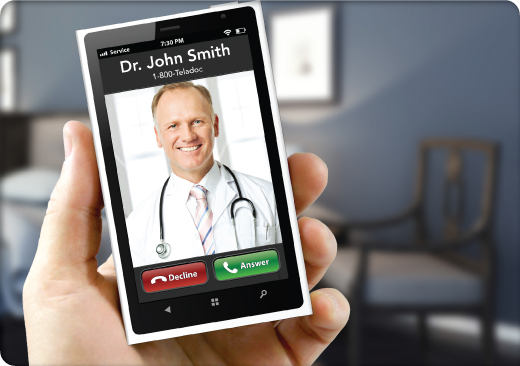Doctors by Phone
 Compared to patients who visited a physician’s office for a similar condition, adult Teladoc users were younger and less likely to have used health care before the introduction of Teladoc. Patients who used Teladoc were less likely to have a follow-up visit to any setting, compared to those patients who visited a physician’s office or emergency department. Teladoc appears to be expanding access to patients who are not connected to other providers. (Health Affairs)
Compared to patients who visited a physician’s office for a similar condition, adult Teladoc users were younger and less likely to have used health care before the introduction of Teladoc. Patients who used Teladoc were less likely to have a follow-up visit to any setting, compared to those patients who visited a physician’s office or emergency department. Teladoc appears to be expanding access to patients who are not connected to other providers. (Health Affairs)


Very interesting!
It is usually for common inquiry.
This is likely why they do not have follow up visits. It is like an interactive WebMD.
Who exactly are treating these patients though? Are they MDs? PAs? What is the credibility of these diagnoses if it is unknown that you are talking to a qualified medical professional.
“Analysis Of Teladoc Use Seems To Indicate Expanded Access To Care For Patients Without Prior Connection To A Provider”
This would be the most likely outcome I would assume, since younger people would be more inclined to use Teladoc, because of its ease in access. As well as most young people likely not having a health care provider.
“Patients who used Teladoc were less likely to have a follow-up visit to any setting”
I am curious as to what leads them to be less likely for a follow up visit. Since access to care is easier and there is no face-to-face interaction, one would conclude that they would be more likely to have a follow up visit.
Perhaps the hypochondriacs have yet to catch on to teladoc.
It is a revolutionary way to access medical care. Yet, I have my doubts about its efficiency. I don’t think someone can prescribe medicines with a phone call. Also it is removing the patient doctor interaction, which is vital for a better health.
Patients who used Teladoc were less likely to have a follow-up visit to any setting, compared to those patients who visited a physician’s office or emergency department.
Follow-up… Is that the same as saying TelaDoc patients are less likely to waste money on an unnecessary doctor’s visit compared to hypochondriacs who run to their doctor at the drop of a hat!
“Teladoc “visits” we studied were for a broad range of diagnostic categories, the most common of which were acute respiratory conditions, urinary tract infections, and skin problems.”
Apparently, a prudent patient always goes back to the doctor a second time to follow up after the first visit.
It simply is not medical care. It is a cash generator with no consequences.
Say Cheese!!!
Yesterday, I attended the launch of the Alliance for Connected Care (www.connectiwthcare.org), of which Teladoc is a member.
The CEO, Jason Gorevic, spoke at the launch. He said that when he joined Teladoc in 2009, he thought it would immediately grow dramatically. It has taken longer than expected.
The Alliance’s members have a number of legislative changes for which they are lobbying. They are very seriously invested: Senators Daschle, Lott, and Breaux are the leaders of the effort, which is run by DLA Piper.
One of the changes they want is a national standard of connected health. For example, in some states, physicians cannot prescribe after solely a teleconsult. The Alliance would like this to change and have influenced legislation that would do so.
Those who are interested in whether the practice of medicine should be regulated by states or the federal government should pay close attention to the Alliance.